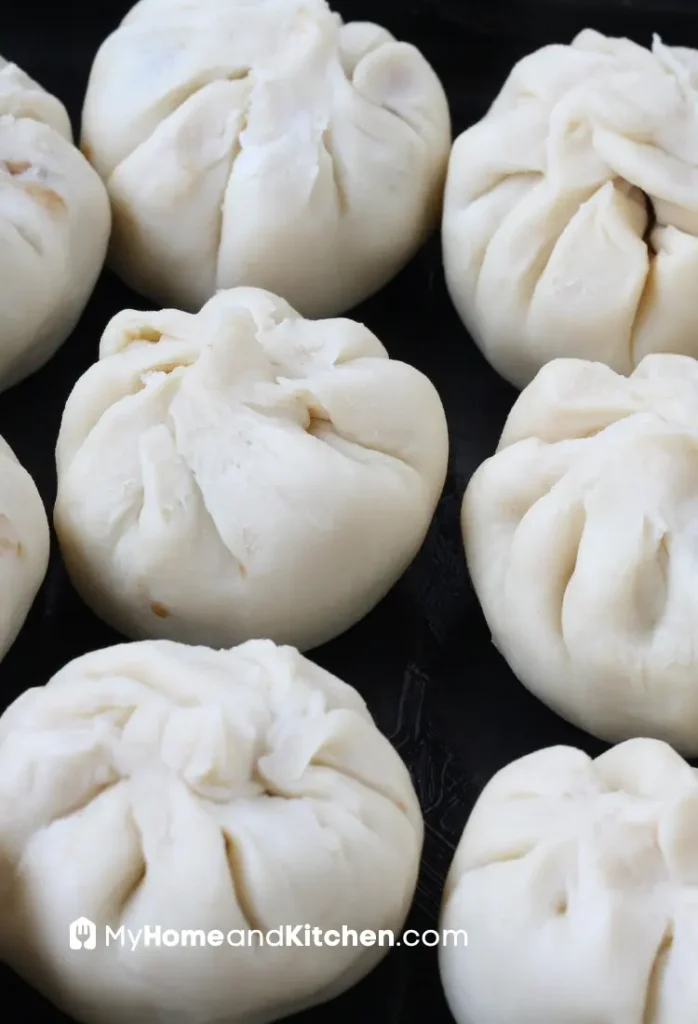Our kitchen is where the delicious magic unfolds. I’m all about simple recipes and sharing them with our online pals
How To Cook Frozen Steamed Buns
Sweeter than their dumpling relatives, steamed buns (also referred to as bao buns) are a delicious Chinese delight consisting of a white dough made from yeast, milk, flour, baking powder, and oil, and stuffing that can be filled with meat, vegetables, or an interesting mix of both!
Steamed buns are extremely popular thanks to their fluffy textures and portable sizes. You can find them in your local Asian restaurant or specialty markets. They’re the perfect snack or appetizer with incredibly versatile ingredients for everyone of all ages to enjoy.
To cook frozen steamed buns, you have to thaw them first depending on how they were stored. Boil water to medium-high heat and place a steamer on top with the buns in it. For frozen filled buns, let it steam for 15 minutes, and for unfilled buns, steam for only less than 3 minutes.
How To Cook Frozen Steamed Buns?
The exact time for steaming is different for various sizes of steamed buns and how many buns you’re planning to heat. If the buns are relatively big and with fillings, make sure you thaw them well before heating them. Unfilled buns usually take less time to heat up.
Here’s a detailed guide on how to cook frozen steamed buns:
- Place a steamer bucket or pan on top of your steamer then boil some water. You can also just use the steamer directly. The heat should be at about 350°F temperature.
- Thaw the frozen steamed buns inside the refrigerator before cooking. If they’re already stored in the fridge, let them rest at room temperature.
- Lower the heat of the steamer once the water starts boiling. It should be set to medium-high. Then, lightly oil the steamer with olive oil or cooking oil then put the buns inside the bucket, pot, or directly on top of the steamer before covering using the lid.
- Steam for 15 minutes for frozen, filled buns. For unfilled buns, it would take anywhere from 1 to 3 minutes for them to be fully cooked.
Tip: make sure you have a dishcloth or paper towel beneath each bun to catch any condensation that seeps from the buns. This is also to avoid making the buns soggy. If you’re cooking steamed buns for a dinner, party, or special occasion, make sure you reheat minutes before the actual event.

Can You Cook Steamed Buns Without A Steamer?
Yes, you definitely can and there are a lot of ways too! If you don’t have a steamer in your kitchen, use a stove, microwave oven, oven, and even a rice cooker. Although they’re not exactly traditional ways of cooking steamed buns, they still work efficiently.
Pro-tip: the buns are well-cooked if they’re soft and heated inside. Use a knife and poke the bun then pull it out gently. Touch the knife and feel if it’s hot—if it is, then the bao buns are done.
Stove
Put water inside a large-sized pot on top of the stove heated at 350°F. Place the buns in a tea towel then put them inside the pot and steam for 8 to 10 minutes depending on the size of the buns.
You can opt to place them in a plastic wrap with poked holes and then put them on a microwaveable dish with water. This will take about 10 minutes for the buns to be fully cooked.
Microwave Oven
Preheat your microwave oven to 350°F. Wrap the steamed buns in a damp paper towel as a way of reintroducing steam moisture to the buns. You can also try drizzling water on the steamed buns and then wrap them loosely in plastic before microwaving.
Afterward, just place the buns inside the oven and microwave at intervals of 10 seconds. A refrigerated bun should be cooked at around 20 seconds while a frozen bun will take 30 to 40 seconds.
Another way you can try to microwave bao buns is to place them on top of a microwaveable cup with water inside then place them inside the microwave. The cup of water will act as a makeshift steamer if you don’t have one.
Oven
If you have a standard oven instead, just directly place the bao buns wrapped in aluminum foil on a baking tray inside the oven. You can try lightly dabbling olive oil on the baking tray if you want. The oven should be preheated at 350°F before cooking.
Cover all the bao buns with the foil and bake for about 10 to 15 minutes for refrigerated buns. Take note that frozen buns may need more time. The foil helps avoid the risk of making your buns too brown on the top.
Rice Cooker
Perfect for students or anyone who’s in a tight pinch and doesn’t have any of the equipment mentioned above. Some rice cookers even have steamer-like attachments but it will work fine without one.
Boil 1 to 2 inches of water inside the rice cooker and attach the steamer add-on. If you don’t have any, place a plate on top of a bowl then let the water boil before placing the bao buns and closing the lid. Let it steam for 7 to 8 minutes for frozen buns and 2 to 3 minutes for refrigerated buns.
How To Store Frozen And Cooked Steamed Buns
Cooked bao buns will last longer if you freeze them instead of putting them in the refrigerator. This principle applies to frozen bao buns too. Remember that the ideal temperature for storing in a refrigerator is 0 °F or lower and for the freezer, it’s 0°F.
Check the table for the shelf life of each steamed bun depending on where they’re stored and if they’re cooked or not:
| Steamed Buns | Refrigerator Shelf Life | Freezer Shelf Life |
| Frozen | 2 to 3 days | 4 to 6 weeks |
| Cooked | 3 to 4 days | 4 to 6 weeks |
What To Serve With Steamed Buns?
For side dishes, you can try salads (asparagus or carrot), fried rice, noodles (rice or spicy sesame), vegetables (stir-fried, sauteed, pickled, or roasted), coleslaw, omelets, sauces (sweet chili or soy sauce), noodle soups, and even dumplings.
For beverages, sake and green tea are classic choices. Other non-alcoholic options are lemonade, black tea, apple cider or sparkling cider, and soda. You can also use wine such as Champagne, Chardonnay, Zinfandel, Pinot Noir, Riesling, and Port.


